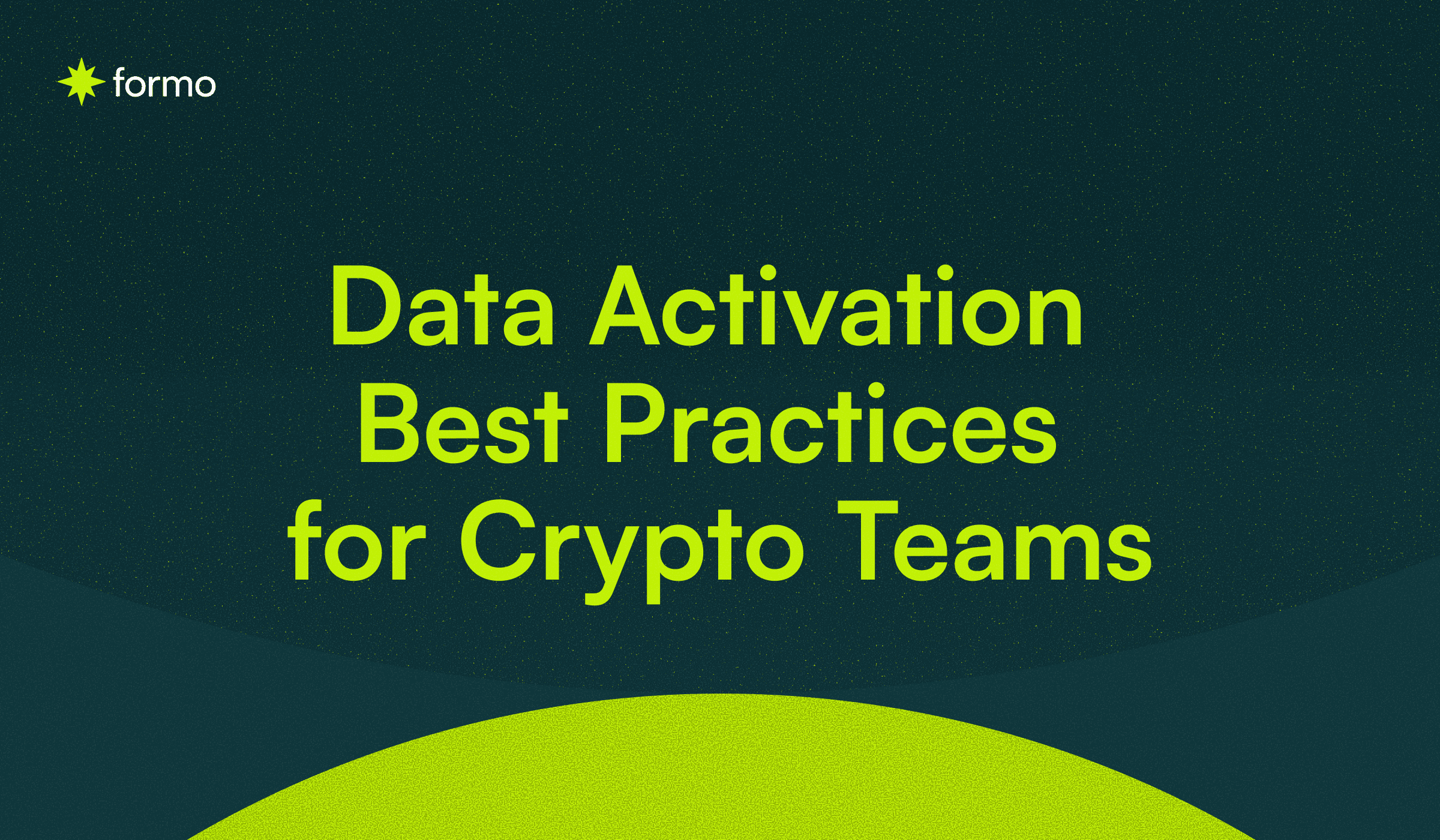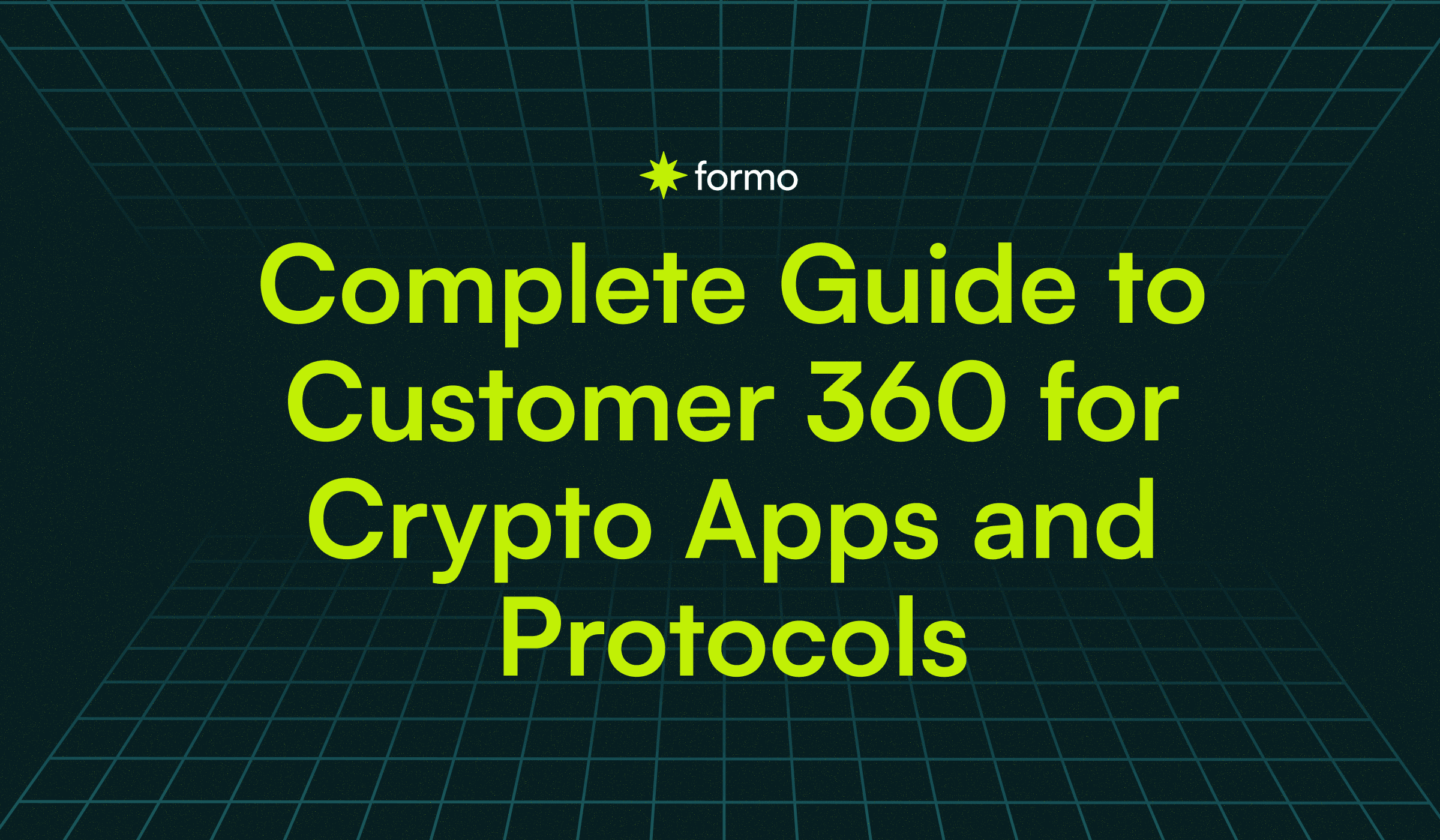A Web3 marketing playbook is your team’s essential guide to aligning on growth goals, tactics, and tools across all campaigns. In the fast-moving world of crypto, staying in sync is critical, especially as wallet behaviors, onchain trends, and decentralized ecosystems constantly evolve. This guide walks you through the core principles of effective Web3 marketing, from channel selection and campaign strategy to tooling and performance measurement.

Why a Web3 Marketing Playbook Is Key to Decentralized Growth Strategies
Key Takeaways
A Web3 marketing playbook aligns teams around wallet-native goals, tools, and tactics.
Wallet insights and onchain analytics go beyond vanity metrics and traditional KPIs.
Community-led growth is a core engine.
Map your funnel to wallet behaviors, not just web traffic.
Use tools like Formo to unify onchain and offchain signals for better targeting.
What Is a Web3 Marketing Playbook?
A Web3 marketing playbook is a practical guide for product and marketing teams navigating the crypto landscape. It outlines strategies to promote dApps, build brand trust, and scale growth through Web3-native channels.
It serves as an operational manual for marketing strategy across:
Growth goals
Target audience
Marketing channels
Campaign tactics and tools
How to measure outcomes
Why Your Web3 Team Needs a Playbook
Web3 teams often rely on siloed experiments or vanity KPIs. A marketing playbook brings structure to that chaos—documenting what's working, syncing your team, and helping you scale repeatable growth motions.
Some benefits include:
Clear direction for contributors, partners, or community mods
A living knowledge base for launching, optimizing, and iterating
Faster onboarding for new hires or community leads
Onchain and offchain alignment in your growth loops
Understand the Market
To effectively market a product, you must have a deep understanding of your market and your target audience. Research helps you determine where to build, who you're building for, and how to reach them.
Understand the Web3 Market
Before marketing, ensure you're building something the market needs. Web3 is broad—DeFi, NFTs, gaming, infrastructure, and more. Research helps you:
Identify demand and product gaps
Spot macro trends (e.g., tokenization of assets, decentralized identity)
Follow funding flows and industry reports (e.g., Cointelegraph Research)
Avoid saturated sectors and big-player competition—look for niches and tailwinds
Tip: Think small to win big. Niche audiences often lead to stronger product-market fit.
Competitive Research
Study what others are building to learn how to differentiate:
Find competitors using tools like Crunchbase, AngelList, and Google keyword research
Analyze their features, messaging, and user feedback
Track their ad strategies via tools like Inflow or the Google Ad Transparency Center
Know Your Target Audience
Audience research informs what to build, how to talk about it, and where to reach users:
Segment user behaviors (e.g., DeFi degens vs. conservative users)
Discover hangouts like Discord servers, Reddit threads, or Farcaster channels
Refine messaging by understanding their motivations and language
Build Web3 User Personas
Create a detailed Web3 user persona to shape your strategy. Examples include:
Early adopters: tech-savvy, curious
Crypto enthusiasts: risk-tolerant, DeFi-native
Mainstream users: less technical, need onboarding
Investors/speculators: profit-focused
Mapping the Web3 Marketing Funnel
The Web3 marketing funnel visualizes the user journey—from discovering your product to becoming an engaged user. It consists of three core stages:

A Visual Breakdown of the Core Web3 Marketing Funnel
1. Awareness (Top of Funnel - TOFU)
Focus on clear, compelling messaging that educates or entertains. Avoid hard selling—invite users to learn more.
Common TOFU channels include:
Twitter Spaces, Discord
Blog posts, SEO content, newsletters
Thought leadership, videos, paid ads
Best practices:
Use strong messaging and visual identity
Tell stories that resonate
Be authentic—avoid a corporate tone
Provide value upfront
2. Education (Middle of Funnel - MOFU)
Engage leads who show interest with deeper content. Highlight how your product solves specific problems.
Effective MOFU tactics include:
Whitepapers, case studies
Learn-to-earn campaigns
Downloadable guides, webinars, and meetups
Social proof and user stories
Best practices:
Focus on value, not just features
Share unique insights or success stories
Prioritize sustainability over trend-hopping
Use community-created content where possible
3. Conversion (Bottom of Funnel - BOFU)
At this stage, emphasize action and clarity. Show proof, reduce friction, and build confidence.
Useful BOFU tactics include:
Product demos, competitive comparisons
Incentives (token rewards, quests)
Embedded forms, simplified signups
Hackathons, open-source tools
Referral programs
Best practices:
Use clear, action-oriented CTAs
Reduce steps to get started
Encourage community referrals
Keep founders visible and responsive
7 Steps to Build Your Web3 Marketing Playbook

7 Essential Steps to Build a Winning Web3 Marketing Playbook
Step 1: Define Objectives
Clear goals inform channel choices, messaging tone, and success metrics.
Examples:
Launching a token? Focus on education, liquidity, and community.
Onboarding users to a dApp? Optimize UX and wallet outreach.
Recruiting DAO contributors? Highlight purpose, incentives, and governance rights.
Define success:
500 allowlist signups from engaged wallets
10% boost in returning wallets across product journeys
Reach 1k Casts from real users via referral campaigns
Step 2: Understand Wallet Audiences
Segment your audience by wallet types, behaviors, and motivations:
Collectors: Active in NFT mints and drops
DeFi Degens: Yield chasers, protocol switchers
Builders: Developers, creators, tool tinkerers
DAO Voters: Governance-participating token holders
Web2 Newcomers: Just getting started, need education
Use tools like Formo’s Wallet Profiles to build smarter segments and design journeys that resonate. A data-informed persona is your biggest Web3 growth asset.
Step 3: Map a Funnel to Wallet Behaviors
Rethink your funnel to align with wallet-native behaviors:
Top of Funnel (TOFU): Educational content, incentives, and Twitter Spaces
Middle Funnel (MOFU): Quests, allowlists, gated content, AMAs
Bottom Funnel (BOFU): Onchain activity like minting, staking, voting, or trading
Step 4: Go to Market & Execute
Plan a Web3 marketing strategy cadence across Web3 marketing channels:
Social Media: Twitter, Discord, Reddit, Farcaster, Console
Online Events: X Spaces, AMAs, webinars, and office hours
SEO & AI Search: Google, Bing, and other AI-optimized search
Email Marketing: Paragraph, Mailchain
Other Channels: PR, influencer marketing, affiliate marketing, wallet messaging
Step 5: Activate Community-Led Growth
Leverage community-led growth as a core engine:
Turn power users into ambassadors
Launch referral programs with token/NFT rewards
Offer governance rights or unique NFTs to top contributors
Use Discord, Telegram, Twitter Spaces, and forums
Step 6: Integrate Onchain & Offchain Touchpoints
Get the full picture by connecting multiple data layers:
Wallet behavior (onchain analytics)
Discord engagement (roles, activity)
Social presence (Twitter, Farcaster, Lens)
Unified insights help you personalize campaigns, segment users effectively, and measure attribution across both Web2 and Web3 channels.
Step 7: Measure, Learn, and Iterate
Track what matters:
How many wallets took action
Which campaigns moved real assets or behavior
Where your traffic is coming from
Web3 Marketing Tools and Technology Stack
Use Case | Tools |
CRM & Segmentation | Formo, Addressable, MetaCRM |
Growth Analytics | Formo, Cookie3, Safary |
Onchain Attribution | Formo, Spindl |
Onchain Data | Dune, Flipside, Allium |
Social Campaigns | Layer3, Galxe, Zealy |
Content Publishing | Mirror, Paragraph, Substack |
Community Management | Guild.xyz, Collab.Land |
Forms Building | Formo, DeForm, Tally |
Measuring Success in Web3 Marketing Strategy
Web3 success depends on wallet activity and long-term value creation. Here's how to shift your mindset and measurement strategy:
Traditional vs. Web3 Metrics
Traditional Metrics | Web3 Metrics |
CTR | Wallet Conversion Rate |
CPA | Cost Per Wallet |
CAC | Wallet Acquisition Cost |
Retention | Wallet Cohort Retention |
CLTV | Revenue Per Wallet (RPW) |
ROI | Onchain ROI |
Web3 shifts measurement from traditional tracking to wallet-native signals, emphasizing onchain behavior over vanity metrics.
Key Web3 Performance Indicators (KPIs)
Cost per Wallet (CPW)
Wallet Acquisition Cost (CAC)
Customer Lifetime Value (CLTV)
Revenue Per Wallet (RPW)
Onchain Activation Rate
Wallet Cohort Retention
Community Contribution Index
Referral Conversions
Onchain ROI
Top Web3 Marketing Tactics
1. Community Building
Establish presence on Discord, Telegram, Farcaster, Lens
Use DAO governance and token voting for transparency
Run AMAs, polls, memes, and community calls
Host workshops, hackathons, and IRL/online events
Offer perks such as incentives, sneak peeks, or exclusive access
Ex: Nike’s .SWOOSH platform enables fans to co-create digital products and participate in the brand’s value creation.

Nike Enters Web3 with NFT Collection and Metaverse Platform Launch
2. Content Marketing
Create SEO blog posts, explainers, case studies, and newsletters
Use visual formats such as infographics, short videos, and interactive guides
Repurpose content into social threads, TikToks, and Reels
Encourage user-generated content (UGC), guest posts, and community features
Ex: Arbitrum publishes consistent ecosystem updates, case studies, and technical deep-dives to educate and engage users.
3. Social Media Marketing
Focus on platforms like X (Twitter), Discord, Farcaster, and Telegram
Explore decentralized platforms: Peepeth, Minds, Mastodon, Lens
Mix memes, product updates, tutorials, and educational threads
Run AMAs, reward programs, and bounties tied to social actions
For example, Lens Protocol utilizes decentralized networks to showcase its ecosystem and drive participation through token rewards.
4. Influencer & PR Marketing
Partner with Web3-native influencers and educators (especially on X and YouTube)
Publish thought leadership content, guest articles, or op-eds
Pitch to Web3 media like The Block, CoinDesk, or Bankless
Use PR platforms like Coinscribble or Chainwire for distribution
Ex: Uniswap gained momentum through trusted community figures and ecosystem coverage of its incentives.

Inside Uniswap’s Web3 Marketing Strategy
5. Token-Gated Growth & NFT Marketing
Use tokens/NFTs for access to gated communities, early features, or special rewards
Launch branded NFTs with real-world or in-product utility
Collaborate with creators and marketplaces (OpenSea, Rarible, Foundation)
Ex: Starbucks Odyssey rewards users with NFT-based stamps earned through real-world actions, unlocking perks and events.
6. Strategic Partnerships
Partner with complementary tools, chains, or communities
Launch co-branded campaigns, joint AMAs, or cross-promotions
Build in public with open-source collaborations
Ex: Polymarket’s partnership with X has significantly boosted its reach and credibility within the prediction markets space.

Polymarket x X Partnership Expands Access to Decentralized Prediction Markets
7. Web3-Native Advertising
Use Addressable, Hypelab, and Slise for decentralized ad distribution
Let users opt into ads and reward them with tokens
Avoid centralized platforms that limit crypto-related ads
8. PPC & SEO for Web3
PPC Tactics:
Run PPC on Reddit, Google Ads, and Twitter Ads (crypto-friendly formats)
Target crypto-native keywords like “mint NFT safely” or “Web3 marketing analytics tools”
Track ROAS, CTR, and conversions
SEO & AEO Tactics:
Use niche tools or community forums for keyword research
Optimize metadata, site structure, and internal linking
Encourage backlinks through collaborations and UGC challenges
9. Growth with Bounties
Run onchain bounty campaigns for content, bugs, referrals, and more with platforms like Boost and Tunnl
Use token airdrops to reward early users or incentivize actions
Ensure clear guidelines and reward mechanisms
Ex: Uniswap’s airdrop of UNI tokens incentivized early adoption and turned users into evangelists
The Web3 marketing playbook is about building trust, aligning incentives, and tracking real wallet activity. With the right mix of wallet insights, community activation, and onchain attribution, your strategy becomes scalable, measurable, and truly wallet-native.
The most effective Web3 marketers know how to turn wallets into contributors and communities into ecosystems. Whether you're launching a dApp, growing a DAO, or scaling an entire protocol, the fundamentals stay the same: understand your audience, align on goals, and use the right tools to turn insight into action.
Further sources:
Web3 Marketing Strategy: A comprehensive guide for beginners
Mastering Web3 Marketing Attribution Analytics: A Complete Guide
Follow us on LinkedIn and Twitter, and join our community to learn how Web3 teams turn insights into action with Formo!
FAQs
1. What is a Web3 marketing playbook?
A Web3 marketing playbook is a strategic and tactical guide that helps teams align around decentralized growth strategies, wallet-native tools, and key performance indicators (KPIs). It outlines how to plan, execute, and measure marketing campaigns in the Web3 ecosystem—from user acquisition to onchain activation.
2. How is Web3 marketing different from Web2 marketing?
Web3 marketing shifts the focus from centralized identifiers like cookies and email lists to decentralized metrics such as wallet addresses, onchain activity, total value locked (TVL), and protocol volume. Instead of tracking clicks and impressions, Web3 marketers prioritize wallet engagement, governance participation, and community contribution.
3. What tools are essential for a Web3 marketing stack?
An effective Web3 marketing stack blends onchain analytics, community engagement, and wallet-based CRM. Core tools include:
Formo – Wallet analytics, segmentation, and Web3-native forms
Paragraph – Email newsletters tailored for wallet audiences
Dune – Onchain dashboards and custom analytics
Galxe / Layer3 – Campaign tools for quests, rewards, and bounties
Guild.xyz / Collab.Land – Community access and role management
4. How do I measure success in Web3 marketing?
To measure performance in Web3, focus on wallet-native KPIs that reflect real onchain engagement:
Revenue Per Wallet (RPW) – Average revenue generated per wallet
Onchain Activation Rate – % of new wallets completing a key onchain action
Community Engagement – Discord, Farcaster, or DAO activity levels
Wallet Cohort Retention – How many wallets stay active after 7, 30, or 90 days
These metrics go beyond vanity stats to reveal the actual value and behavior of your user base.
5. How can I grow and retain a Web3 user base?
Web3 growth requires more than ads—it’s about creating value, building trust, and aligning incentives. Here’s how:
Build trust through transparency and consistent communication
Design meaningful onchain journeys with actions like minting, voting, and staking
Educate users with personalized content (e.g., learn-to-earn, gated guides)
Leverage wallet segmentation to tailor campaigns by behavior and intent
Track the full funnel—from awareness to onchain conversion—with tools like Formo





